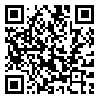Volume 25, Issue 2 (7-2019)
Back to this Issue |
Back to browse issues page
Download citation:
BibTeX | RIS | EndNote | Medlars | ProCite | Reference Manager | RefWorks
Send citation to:



BibTeX | RIS | EndNote | Medlars | ProCite | Reference Manager | RefWorks
Send citation to:
Jafari Kheirabadi A, Froutan R, Mazlom S R, Rohani Baygi H. A comparative study of the tracheal tube fixation using band, adhesive and holder on the incidence of pressure ulcers in patients with head trauma
. Journal of Hayat 2019; 25 (2) :179-194
URL: http://hayat.tums.ac.ir/article-1-3011-en.html
URL: http://hayat.tums.ac.ir/article-1-3011-en.html
1- Dept. of Critical Care Nursing, School of Nursing and Midwifery, Mashhad University of Medical Sciences, Mashhad, Iran
2- Dept. of Medical Surgical Nursing, School of Nursing and Midwifery, Mashhad University of Medical Sciences, Mashhad, Iran ,Froutanr@mums.ac.ir
3- Dept. of Medical Surgical Nursing, School of Nursing and Midwifery, Mashhad University of Medical Sciences, Mashhad, Iran
4- Dept. of Anesthesiology, School of Medicine, Mashhad University of Medical Sciences, Mashhad, Iran
2- Dept. of Medical Surgical Nursing, School of Nursing and Midwifery, Mashhad University of Medical Sciences, Mashhad, Iran ,
3- Dept. of Medical Surgical Nursing, School of Nursing and Midwifery, Mashhad University of Medical Sciences, Mashhad, Iran
4- Dept. of Anesthesiology, School of Medicine, Mashhad University of Medical Sciences, Mashhad, Iran
Abstract: (3695 Views)
Background & Aim: Brain injury is one of the most common traumas and the most important cause of death in traumatic events. Ventilated patients are susceptible to pressure ulcers caused by endotracheal tube fixation (ETF). The aim of the present study is to compare three methods of ETF (band, adhesive and holder) on the incidence of pressure ulcers in patients with head injury.
Methods & Materials: This randomized clinical trial was performed in a hospital in Mashhad in 2017. A total of 108 hospitalized patients with head trauma were included in the study by convenience sampling. The patients were randomly divided into three groups of ETF using holder, band and adhesive. In three groups, the incidence of pressure ulcers caused by fixation method was assessed at 6, 12, 18, and 24 hours after the intervention. The grade of ulcer was measured by pressure grading scale (EPUAP/NPUAP). The data were analyzed using the SPSS software version 16.
Results: The incidence of pressure ulcers at 6, 12, 18, and 24 hours after the intervention was significantly different in the three groups (P<0.05). At six and 12 hours after the intervention, the three groups had a grade one ulcer. However, after 18 hours, 10% in the adhesive group and band group and 24 hours after the intervention, 25% in the band group and 12.1% in the adhesive group had a grade 2 pressure ulcer, but this amount was 0% in the holder group.
Conclusion: Use of holder rather than adhesive and band for ETF in mechanically ventilated patients causes less pressure ulcers.
Clinical trial registry: IRCT20171015036800N1
Methods & Materials: This randomized clinical trial was performed in a hospital in Mashhad in 2017. A total of 108 hospitalized patients with head trauma were included in the study by convenience sampling. The patients were randomly divided into three groups of ETF using holder, band and adhesive. In three groups, the incidence of pressure ulcers caused by fixation method was assessed at 6, 12, 18, and 24 hours after the intervention. The grade of ulcer was measured by pressure grading scale (EPUAP/NPUAP). The data were analyzed using the SPSS software version 16.
Results: The incidence of pressure ulcers at 6, 12, 18, and 24 hours after the intervention was significantly different in the three groups (P<0.05). At six and 12 hours after the intervention, the three groups had a grade one ulcer. However, after 18 hours, 10% in the adhesive group and band group and 24 hours after the intervention, 25% in the band group and 12.1% in the adhesive group had a grade 2 pressure ulcer, but this amount was 0% in the holder group.
Conclusion: Use of holder rather than adhesive and band for ETF in mechanically ventilated patients causes less pressure ulcers.
Clinical trial registry: IRCT20171015036800N1
Send email to the article author
| Rights and permissions | |
 |
This work is licensed under a Creative Commons Attribution-NonCommercial 4.0 International License. |






